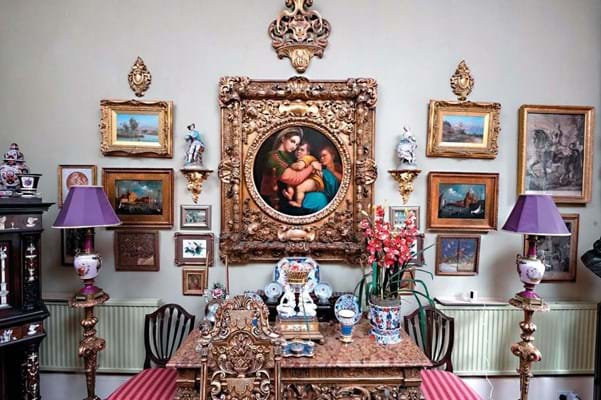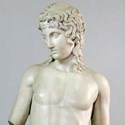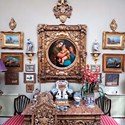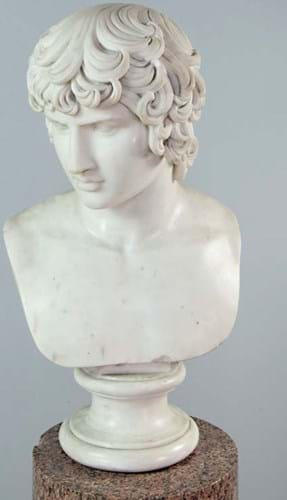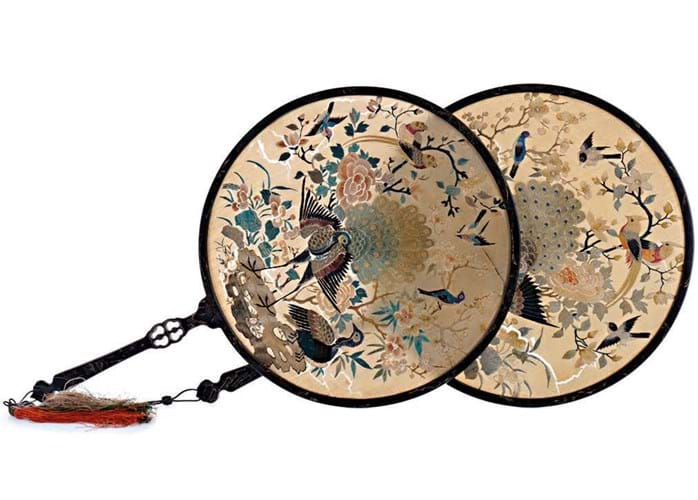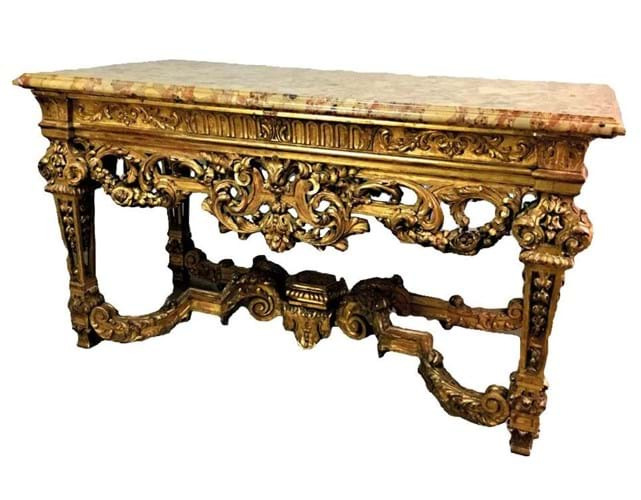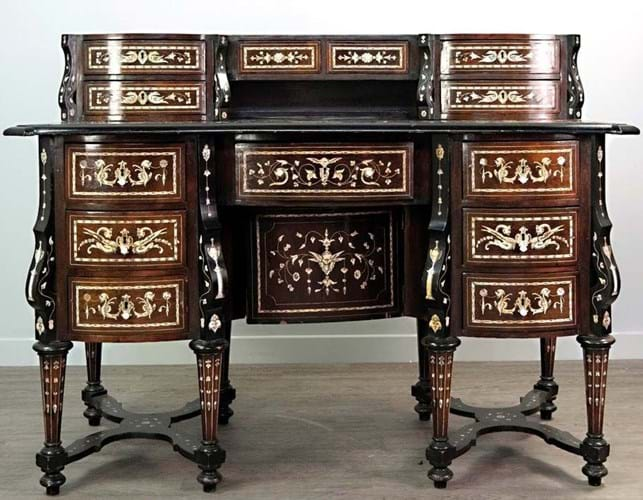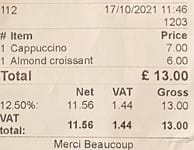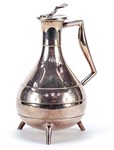For the hundreds of guests from the worlds of theatre and dance whom William Mowat-Thomson entertained over the years at his sumptuous receptions, McTear’s (24% buyer’s premium) sale catalogue was a window to pre-pandemic partying.
Nearly 1000 lots from his townhouse in one of Edinburgh’s finest Georgian streets reflected the style of Mowat-Thomson, who arrived in the city from his Orkneys home as a hard-up young man in the 1950s determined to pursue his passion for dance.
His role as a pioneer driving force in Scottish ballet and a renowned teacher was the feature of obituaries when he died aged 85 in February.
But it was his interest in art and antiques which drew UK and international bidders – 1320 of them registered online – to the September 17-18 Glasgow sale.
Mowat-Thomson, boosting his income from dance with some shrewd property development, could afford an opulent lifestyle but his tastes and pockets steered his purchases towards the decorative rather than the academic.
Quality eye-catchers
For instance, neither of the two century Carrara marble carvings which led the sale were attributed to a sculptor but both were top-quality eye-catchers.
A torso of a youthful, beardless Apollo was catalogued as Grand Tour. With an overall height of 5ft 8in (1.73m) on its simulated scaglio marble plinth, it was pitched at £4000-6000 but sold online at £26,000 to the London trade.
A 19th century bust of Antinous, Emperor Hadrian’s lover, standing on a pink marble cylindrical column and square base, 6ft 1in (1.86m) high, went similarly above estimate, going to a Belgium gallery at £13,000.
Private admirers of marble got a look-in when a 13¼in (34cm) tall Grand Tour-style Sienna marble model of the Temple of Vespasian in Rome headed to a London buyer at £1700, more than eight times the top estimate.
The 955 lots covered a pretty comprehensive range of collectables, mostly eminently affordable. Only about 40 were bid into four figures but almost all were enthusiastically competed for. As a result, against hopes of £95,000-150,000, the hammer total was £280,000 with only 20 lots failing to sell.
Occasional treasure emerged among the eclectic offerings such as a 19th century Italian version of Raphael’s tondo Madonna Della Sadia among some 90 mezzotints, engravings, ‘school of’ oils and minor water colours.
The 2ft 4in (72cm) diameter oil on canvas was inscribed to verso Puccio Puccinella Copia and bore the trade label of Pierre Bazzanti & Fils of Florence. A selling point was its extravagantly decorative, 5ft x 4ft 2in Florentine giltwood frame and crest, helping it to a bid of £6500 from a London dealer against a £2000-3000 guide.

As guests saw William Mowat-Thomson’s home – with Italian cabinet (£4000 at McTear’s) and Dutch delft vase (£5000).
Among the ceramics, the star was a Dutch delftware blue and white baluster vase and domed cover. It was dated to the early 19th century. Adorned with insects among foliage, the 2ft (60cm) tall vase decorated in underglaze blue with insects was pitched at £100-200 and went to an English collector at £5500.
Best of the glass was a Georgian 10in (25.5cm) tall candlestick with wrythen fluted sconce on a double Silesian stem which made a seven-times top-estimate £1400.
The silver star was a 2ft 3in (69cm) tall silver-framed oval mirror by the highly regarded William Comyss, London 1887, which went at £1200, five times the top estimate.
Mowat-Thomson, shrewd collector-dealer though he was, doubtless paid more for his pieces in the boom years than they made in 2021, but his Chinese items drew interest from across the Far East and probably represented a profit.
They included a 19in (48cm) tall, late 19th century table screen with pierced and carved frame with a silk panel embroidered with peacocks, which took £1300 (estimate £100- 200) and the similarly dated and decorated pair of silk and lacquered hand fans shown here. With pierced handles and heart-shaped finials, the 17in (43cm) diameter fans pitched at £40-60 sold to a Chinese online bidder at £1600.
China also featured among the furniture, the sale’s main strength, in the form of an early 20th century hardwood extending dining table.
With concealed frieze drawers and twin carved supports, it was ornately decorated with incised key designs, panels of pierced brass and of rosewood with mother of pearl. It went to the London trade at a double-estimate £3800.
Eastern influence
More influence of the East was seen among English pieces when a near pair of George III Chinese Chippendale mahogany elbows chairs with octagonal trellis work to the shaped backs, rails, arm rests and legs, sold to a Scottish private buyer at a quadruple-estimate £4000.
Highly decorative Continental pieces, however, provided most of the higher prices.
Leading the way was an early 19th century Baroque style giltwood console table by J Sazarin, a notable French maker of furniture in earlier styles.
With a 5ft x 2ft 5in (1.52m x 74cm) Sienna marble top above a concave arcaded and scrolling leaf moulded frieze on four open-section rosette moulded tapering legs, it was estimated at £3000-5000. Of a style much reproduced again in the 20th century for the Middle East, it was underbid by an Egyptian bidder but went to a London private buyer online at a double estimate £9000.
Going further above expectations was a 19th century French giltwood five-piece salon suite of four armchairs and a sofa, all with top rails featuring carved ribbon and floral cresting and with Aubusson tapestry cloth detachable cushions. It quadrupled the estimate at £4000.
From north Italy came two 19th century rosewood pieces attracting interest from Continental and Asian bidders.
One was a bureau mazarin in the manner of Pietro Piffetti (1701-77), the renowned cabinetmaker to King Carlo Emanuele III.
Inlaid throughout in engraved bone with classical motifs, mythical beasts and floral sprays, the 4ft 9in (1.45m) wide multi-drawer bureau went to a Belgian dealer at a five-times estimate £5500.
The other was a rosewood side cabinet inlaid with the maker’s mark, little-known today, for Eugenis Forelli, Firenze 1885.
Profusely inlaid with bone figures of various saints, classical figures, and charioteers, the 3ft 8in (1.13m) wide cabinet doubled the top estimate, going to the English trade at £4000.



